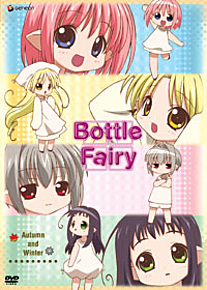Review
by Carlo Santos,Bottle Fairy
DVD 2: Autumn & Winter
| Synopsis: |  |
||
Kururu, Chiriri, Sarara and Hororo, the bottle-sized fairies from another world, continue to study Japanese customs and daily life as they strive to become human. Autumn brings sports festivals and changing greenery, and then winter sets in with Christmas, the new year and Valentine's Day all in a row. The hardest challenge, however, comes when the fairies realize that turning human means having to part ways. Will they have the courage to move on? And even if they do, functioning in the human world might turn out harder than they think. |
|||
| Review: | |||
If you managed to survive the cuteness overload that was Volume 1 of Bottle Fairy, then there's more to look forward to in Volume 2. Continuing in the lighthearted spirit of the first DVD, this set of episodes moves briskly towards a neat little conclusion. The finale encapsulates everything that makes the show fun: goofy gags and puns, bright and simple visuals, and an indomitable can-do spirit. Between that and the casual primer on Japanese culture, it's a guaranteed smile for anyone who appreciates the cute side of life. Like its mini-sized characters, Bottle Fairy comes in a compact package of 12 minutes per episode, which works to its advantage. Other ultralight comedies often flail about for half an hour, hoping for that one killer joke to come, but this show's tighter time frame leads to more funny and less filler. A confluence of holidays also boosts the pacing: a Santa Claus scenario flows right into a New Year's Eve mock-melodrama, which then gives way to a New Year's board game loaded with visual gags. Still, the one-month-per-episode gimmick leads to some unavoidable lulls: the October and November episodes fall flat, mostly because there aren't any major celebrations at that time. Seeing the fairies tend to a flower in mid-November is just plain boring compared to their usual flights of fancy. Despite the series' reliance on childishness and offbeat humor, there are also some moments that manage an air of seriousness—or at least, as serious as a quartet of fairies can possibly be. Their uncertainty about "graduating" to human form is the closest thing to character development; Kururu's fear of losing her friends is particularly heartfelt. Once the fairies get past it, though, the finale becomes a triumphant return to form: boundless energy, silly situations, and even sillier jokes. While it won't appeal to everyone, this show presents an attitude that's all its own. The fairies just don't think like normal humans do, and their loopy innocence sets the tone for everything from beginning to end. Brightly colored visuals are also essential in setting that lighthearted tone; characters and backgrounds alike are decked in warm hues that scream of happiness. Design-wise, the four main characters are in super-deformed style all the time, even when human-sized, which is just a tad creepy. Despite this cookie-cutter cuteness, however, quirky touches like fake screentone dots, pulsating sunbeams and sudden shifts in background (Sarara's samurai fantasies especially) establish a distinctive look. The actual animation, however, is less creative: character movement is noticeably stiff at times, and still-frame shots are used as a quick way out. On the other hand, that recycled clip of cat mascot Oboro-chan floating across the screen never seems to get old. The background music is about the same as what you heard on the first disc: a handful of cheerful melodies programmed and repeated as necessary. The tunes occasionally shift mood and meter depending on the scene, but ultimately the soundtrack and theme songs are pure fluff, just like the show. Keep an ear out for the pleasant ending song, however, which changes lyrics and lead singer every three episodes to suit the season. It all comes together in the final episode when the fairies sing the ending as a group. Although the English dub is bearable, it could have used a lot of improvement: the voice actresses for the fairies are clearly forcing their voices higher, and the result just doesn't feel natural. The frequently-modified script also adds to the problem, throwing off the timing and leading to a stilted delivery. The Japanese dialogue may be squeakier, but it's worth switching to for a more polished performance. On a positive note, the translation staff has managed to work their way around the various puns; the "bento/lunch box for Sensei-san" in the final episode is a particularly tricky one that survives translation mostly intact. Although previews and clean openings/endings are standard fare for DVD extras, it's worth noting that each episode here has a different ending sequence, and all of them are available in clean format on the disc. Although you can't select them individually, just being able to see the unobscured artwork for each ending is a welcome treat. Let's face it: not everyone can stomach the mind-numbing cuteness of Bottle Fairy. But for those who can—and those who thrive on such sugary delights—the second half of the series is just as entertaining as the first, even sprinkling in some plot continuity at the end. No one's going to call it a masterpiece anytime soon, but in the niche world of all things kawaii, this is one of the most intense examples of that style. Anyone looking for the ultimate sugar rush will find it right here. |
| Grade: | |||
|
Overall (dub) : C
Overall (sub) : B
Story : B+
Animation : C
Art : B
Music : C+
+ Still as lighthearted as ever, and short enough that the series ends before running out of jokes. |
|||
| discuss this in the forum (12 posts) | | |||
| Production Info: | ||
|
Full encyclopedia details about Release information about |
||